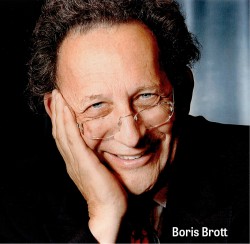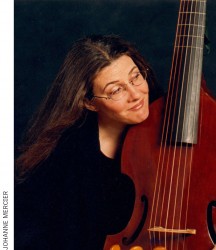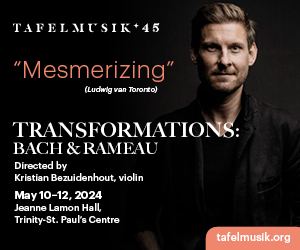Am I just imagining it, or was musical life once much more tidily compartmentalized? There was the season (coinciding with the school year), on the one hand, and the summer on the other. Within the summer there were festivals and concerts to go to , or summer camps and courses one could enrol in.
Nowadays along with overlap between the seasons, there is a blurring of the lines: between summer festivals and academies; between opportunities for music lovers to attend concerts in the usual way and opportunities to become involved in a hands-on way. For serious music students, if you take the summer to recharge your batteries, you have to wonder if you are losing ground between school years. For concert presenters and summer music educators, the challenge is to figure out how to bridge the gap without losing their identity.
 Hamilton’s Brott Festival is an interesting example. Led by conductor Boris Brott, the festival has long boasted a busy annual summer season chock-full of orchestral classics as well as lesser-known works. This year has 11 planned performances so far between June 18 and August 14 (including Berlioz’s Symphonie fantastique, a concert spotlighting Italian and Italian-influenced works, a performance of a Viennese gala evening with works by Strauss, Lehár and Piazzolla and collaborations with the National Ballet and Festival of the Sound). Brott and his team show no signs of letting up.
Hamilton’s Brott Festival is an interesting example. Led by conductor Boris Brott, the festival has long boasted a busy annual summer season chock-full of orchestral classics as well as lesser-known works. This year has 11 planned performances so far between June 18 and August 14 (including Berlioz’s Symphonie fantastique, a concert spotlighting Italian and Italian-influenced works, a performance of a Viennese gala evening with works by Strauss, Lehár and Piazzolla and collaborations with the National Ballet and Festival of the Sound). Brott and his team show no signs of letting up.
But the other side to the Brott story is the National Academy Orchestra (or NAO, to give it its industry acronym). It is the Brott Music Festival’s orchestra-in-residence, made up of a combination of young musicians aspiring to a professional career and seasoned performers who act as their mentors. Now entering its 27th season, the NAO provides its students with performance experience, musical guidance and insight into the real-life working schedule of an orchestral musician.
“We’re right in the midst of the audition process for the NAO,” Boris Brott explained to me in a recent phone conversation. “The NAO is a mentor-apprentice training program that helps musicians create the transition—or survive the transition—after the end of school. It’s very similar to the New World Symphony in Miami, except that the mentors and the players play together in this orchestra; they participate together. We believe very much in the alchemy of that.”
As an ensemble-in-residence for a festival that runs June to August, participation in the NAO certainly is no small commitment. The number of rehearsals and concerts make it a summer program that is less of a vacation and more of a headfirst dive into the orchestral working world. “Most schools ... rarely do more than four concerts a year, which is a very unreal experience from a professional standpoint,” says Brott. “We very much mirror a professional orchestral schedule. The participants absorb so much that way, and some say that it’s probably the best education—from the standpoint of realistic professionalism—that they’ve had.”
Participants, regardless of whether they go on to have full-time orchestral careers, often continue to make use of the NAO connection. In terms of a blurring of the seasonal lines, the Brott Music Festival has recently begun work on some wintertime initiatives, including educational concerts for children and Pops-type collaborations with other Southern Ontario concert presenters. For these shows, which strangely count as being part of the Brott Music Festival’s “off-season,” alumni comprise the performing orchestra.
Brott explains that one of the goals is to provide alumni with working opportunities, which often supplement some other kind of orchestral or ensemble work in the Southern Ontario area. “A lot of alumni stay in this area and become part of what I call the ‘401 orchestra’—orchestras from Kingston right through to Windsor,”
Brott’s list of alumni does look encouraging. In addition to the many members of that ‘401 orchestra’ and musicians involved in chamber music, educational and business initiatives across the country, the GTA alone is full of orchestral musicians who are graduates of the festival orchestra. Ian Hopkin, principal bassoonist of the Kitchener-Waterloo Symphony Orchestra, is an NAO grad, as are Vanessa Fralick and Steven Woomert of the Toronto Symphony. In the search for some musical experience and a little career help, a festival with that kind of alumni track record—and one that provides the opportunity to perform so many much-loved orchestral masterworks—is a tough act to turn down.
The Festival is not resting on its laurels, though. This summer, it will be launching a two-week opera program for professional singers, culminating in a “Popera” excerpts concert and a concert staging of Rossini’s Il barbiere di Siviglia.
It’s no accident that this program arrives on the Hamilton arts scene shortly after the loss of Opera Hamilton. “We have always done opera as part of our festival but we are concentrating it here in a two-week period,” says Brott. “We’re developing it as a program with the intention that the program will eventually have other periods during the season so as to create an opera company for Hamilton.”
Opera Hamilton closed its doors at the beginning of 2014 after being a pillar of the Hamilton music community since 1980. Brott hopes that the Brott opera program will be able to eventually fill the gap left in the Hamilton music scene, in a way that is financially feasible. “Hamilton deserves it. We have a beautiful theatre and we have a wonderful public here,” explains Brott. There could once again be opera to look forward to in Hamilton—both as part of this summer’s programming and hopefully, in the years to come.
 CAMMAC: The More It changes …Across the provincial border, and as different as anything could be from the NAO’s working-schedule orchestral and operatic intensives, is CAMMAC, a music centre on Lake MacDonald, about a 90-minute drive northwest of Montreal. Since 1968, CAMMAC provides myriad summer music programs there, for every age group and level of expertise. The seven weeks of week-long programs from June 28 to August 16 do offer opportunities for advanced players to engage with some challenging work, but CAMMAC is also a little haven of musical activity for non-professionals looking for a more relaxed learning experience or a chance to try something musically new.
CAMMAC: The More It changes …Across the provincial border, and as different as anything could be from the NAO’s working-schedule orchestral and operatic intensives, is CAMMAC, a music centre on Lake MacDonald, about a 90-minute drive northwest of Montreal. Since 1968, CAMMAC provides myriad summer music programs there, for every age group and level of expertise. The seven weeks of week-long programs from June 28 to August 16 do offer opportunities for advanced players to engage with some challenging work, but CAMMAC is also a little haven of musical activity for non-professionals looking for a more relaxed learning experience or a chance to try something musically new.
The WholeNote caught up with Margaret Little, CAMMAC’s new executive director (who also has a busy performing schedule as one of Canada’s pre-eminent viola da gamba players) to talk about the atmosphere of a summer at the music centre. “For me,” says Little (whose parents, Georgeand Madeleine Little were among the founders of CAMMAC in 1953) “Summer has always meant CAMMAC. It’s all about people and about music—and that’s a pretty good recipe.”
CAMMAC summer days are jam-packed but relaxed (there is even an official time slot in the daily schedule for a siesta). A typical morning comprises a concert, a choir session for all of the week’s participants and then a few program-specific classes; afternoons allow for free time to practise, play music with friends and colleagues or explore the centre; and evenings usually mean a choir or orchestra rehearsal followed by a concert, dance or cabaret. Each of the seven weeks of CAMMAC has a specific theme and roster of guest artists.
Like the Brott Music Festival, CAMMAC also has new initiatives and non-summer programming ideas on the horizon: long-weekend programming in the fall and spring; and a brand-new music program available during the first week of March this year—that’s spring break for Quebec students—for grandparents and children.
“Very often during the school break, parents send their kids to day camp or off to their grandparents,” says Little. “So the idea is to send them both to camp.”
The atmosphere of people of different levels of experience learning together is a central pillar of CAMMAC’s philosophy. “It’s not one age group separated from another. Everyone is together and there’s some really nice rencontre,” Little explains. “Children from the age of 12 start following the adult program. They do have special teen classes, teen choir, drumming, stuff like that. But I remember when I was a kid at age 11, playing in the orchestra with all the adults and playing chamber music with them. It was great.”
Whether you’re an ambitious young professional looking for the inspiration of the NAO experience, or you’d rather take the trip over to Quebec for some more relaxed summer learning, both the Brott Music Festival and CAMMAC make for interesting options—and both foster the same spirit of learning and community. It’s this quality, perhaps more than any other, that we all, amateur and professional, music lovers all, look for somewhere on summer’s musical road.



